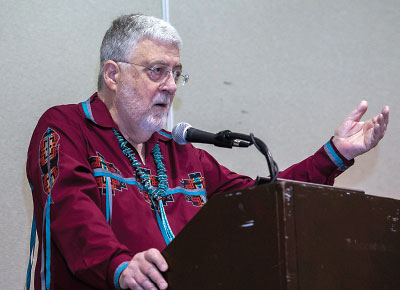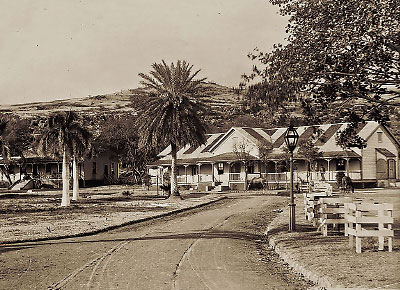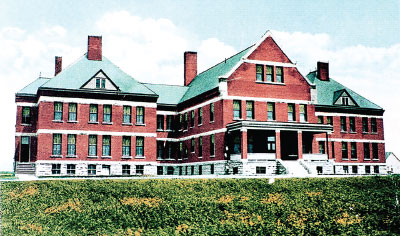MH Care of American Indian, Alaskan Native, and Native Hawaiian Population Has Long History, Uncertain Future
Abstract
Psychiatry’s emphasis on the connection between physician and patient dovetail well with the culture and history of indigenous peoples. This article is part of a yearlong series marking APA’s 175th anniversary.

Traditional treatments for illnesses of all kinds were part of the cultural milieu of American Indians, Native Alaskans, and Native Hawaiians for millennia before the arrival of Europeans, said Roger Dale Walker, M.D., a professor of psychiatry at Oregon Health and Science University School of Medicine, at a session that was part of APA’s 175th anniversary history track at the 2019 Annual Meeting in May.
The early colonists recorded the extensive knowledge that Native Americans had of the medicinal uses of plants, roots, and barks, said Walker, who is of Cherokee origin. He showed a drawing published in a book in 1588 of an Indian village with a garden devoted to growing medicinal plants. Their medicine was a science founded on long-time observation and experience and positive outcomes.
During the 19th century, some indigenous people adopted—on a small scale—the era’s reigning asylum model. King Kamehameha V founded the O‘ahu Insane Asylum in 1866, an institution run by Native Hawaiians that existed until 1930. The Cherokee National Council established the Cherokee Home for the Insane, Deaf, Dumb, and Blind, which opened in 1877 in what is today Oklahoma. In 1898, a U.S. senator from South Dakota successfully obtained federal funding to establish the Hiawatha Asylum for Insane Indians, which operated in Canton, S.D., from 1902 to 1934. The Morningside Hospital in Portland, Ore., held a contract to care for Alaska Natives with mental illness from 1904 to 1968.

Roger Dale Walker, M.D., who is of Cherokee origin, notes that early American colonists recorded Native Americans’ medicinal use of plants, roots, and barks.
While several American Indians became physicians in the late 1800s, indigenous psychiatrists are a 20th-century phenomenon. Herbert Fowler, M.D. (1919-1977), was the first Native American to complete a residency in psychiatry, said Walker. Fowler, who was one-quarter Sioux Indian, established the first mental health clinic on an Indian reservation in 1958 on the Ute Reservation in Utah and served as director of that clinic for six years. He was also the grandson of Charles Eastman, one of the earliest Native American physicians.
Daniel Dickerson, D.O., M.P.H., now an associate research psychiatrist at the University of California, Los Angeles, was the first Alaska Native psychiatrist. Naleen Andrade, M.D., a professor and former chair of psychiatry at the University of Hawai’i John A. Burns School of Medicine, was the first Native Hawaiian woman to become a psychiatrist. H. C. Townsley, M.D. (Creek), became the first American native director of mental health programs at the Indian Health Service in 1976.
Johanna Clevenger, M.D. (Navajo), was the first chair of APA’s Committee of American Indian, Alaskan Native, and Native Hawaiian Psychiatrists and the first Native American woman president of the Association of American Indian Physicians, a post she held twice—in 1982 and 1992. James Thompson, M.D. (Delaware), served as APA deputy medical director and director of APA’s Division of Education, Minority, and National Programs from 1998 to 2002. Thompson restructured that office and expanded recruitment programs for minority medical students.
“We must acknowledge the contributions and sacrifices of those who came before us,” said panelist Mary Hasbah Roessel, M.D. (Navajo), of Santa Fe, N.M. Her choice to become a psychiatrist came in part as a result of her family’s acquaintance with the psychiatrist Karl Menninger, M.D., and her recognition that psychiatry focuses on a holistic approach to patient care, one that combines mind, body, and spirit with interpersonal relationships.

O’ahu Insane Asylum, ca. 1870, opened in Kapālama in 1866 and served long-term psychiatric patients. Its first patients were transferred to the hospital from the jails where mentally ill people had previously been kept.
“Navajos were the first psychotherapists,” Roessel recalled Menninger telling her. During her training in medical school at the University of Minnesota, Menninger sent her letters of encouragement. Such mentoring, she said, is important in disseminating knowledge and support from generation to generation.
Caring for the mental health needs of indigenous patients calls for an understanding of both their culture and history, said Roessel. Recognition of the effects of centuries of historical trauma inflicted on native populations is key to their care. That trauma includes genocidal warfare, geographic displacement, and the system of residential schools that detached Native American children from their culture and identities.
Challenging the conventional wisdom on those issues, recognizing indigenous knowledge, and integrating indigenous principles into psychiatric practice could help improve care for native peoples, she added.
Such an approach would begin by asking patients to articulate their theory of why there is a problem, said Walker. “Then we would ask if they know how this has been treated in the past in their community, and then how Western medicine might be best incorporated into their daily life pattern.”

The Hiawatha Asylum for Insane Indians in Canton, S.D., also known as the Canton Indian Insane Asylum, was open from 1903 to 1934. Many inmates were placed there for “misbehavior” or disagreements with Indian agents.
Traditional healers also employ “talking medicine,” which can be considered a form of psychotherapy.
“When approached for assistance, Native medicine people are active in getting a good history, listening to the person’s description of the problem, and reviewing past issues,” Walker explained in an interview after the meeting. “It is important to listen and let the person talk. The story they tell often leads to the solution. It’s a lot like psychotherapy, although the entire family is also involved.”
Adopting such a mixed model would require increasing the numbers of native mental health workers, he said.
“American Indian, Native Alaskan, and Native Hawaiian [students] are [represented] in the lowest numbers per capita in medical schools of any ethnic group,” said Walker. “We must increase the critical mass of indigenous doctors, including psychiatrists, in the United States.”
Only about 30 native psychiatrists, including five or six child psychiatrists, are now at work in the country, estimated panelist Richard Livingston, M.D., a psychiatrist of Cherokee origin in private practice in Little Rock, Ark. “There’s a lot of work to do and not a lot of us to do it,” he told attendees.
Walker praised APA’s steps to recognize indigenous psychiatrists and support their work. He noted that APA in 1980 was the first U.S. medical association to testify before Congress on behalf of American Indian and Alaskan Native health, advocating for increased research, education, and clinical care.
American Indian, Alaskan Native, and Native Hawaiian people still have significant and largely unmet mental health needs, said the panelists, and more efforts should be addressed to draw in a new cohort of Native physicians and psychiatrists, said Livingston. “We need to help young people identify obstacles in their path and then liberate them to find their own road.”■
Information and toolkit about working with American Indian, Alaska Native, and Native Hawaiian patients is posted here.



